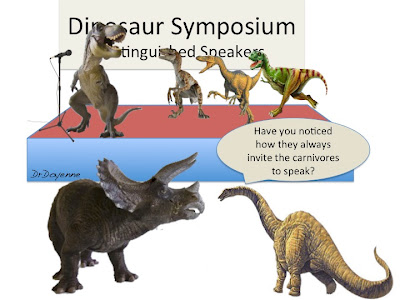Turns out, there is now some evidence that the gender of session organizers has a significant influence on who ends up speaking in the more prestigious symposia sessions.
A recently published paper in PLOS One, "Stag Parties Linger: Continued Gender Bias in a Female-Rich Scientific Discipline", examined participation by women and men at conferences in a field in which women are in the numerical majority. Based on an analysis of 21 annual meetings of the American Association of Physical Anthropologists, they found that in the subfield of primatology:
1. Women gave more posters than talks; men gave more talks than posters.
2. The proportion of female participants was lower in symposia organized by men (29%) compared to those organized by women only (64%) or by both men and women (58%).
They found the same pattern for 12 annual meetings of the American Society of Primatologists.
Primatology is a field that has had more female than male participants since the early 1970s and where women have achieved substantial peer and popular recognition for their achievements (Jane Goodall, Dian Fossey). The results of this study suggest that even numerical dominance by females in a scientific field does not prevent gender bias. By looking at symposia participation, which is typically by invitation of the organizer, in relation to the gender of the organizer(s), the authors were able to say something about whether the underrepresentation by women at conferences might be due to lack of assertiveness by females or to bias. Whereas posters and regular talks are self-motivated, the more prestigious symposia reflect a choice made by the organizer. The results suggest that when men are the organizers, fewer women are invited to participate, but that men and women are equal participants in symposia organized by women (despite the larger numbers of women in the field).
Such bias may be unconscious on the part of the male symposia organizers. I'm just guessing that this is the case as the authors have no data either way. The authors of this paper, however, do state that they "cannot rule out" the possibility that male primatologists are more homophilic (homophily is preferential interaction with others who have similar attitudes, beliefs, or personal characteristics) than women. The idea is that male symposia organizers have to spend more time interacting with their invitees, both before and after the symposium (e.g., to jointly prepare a conference proceedings) and simply prefer to work with other males. Perhaps. The jury is still out on that one. But my guess is that this behavior is not restricted to male primatologists.
The finding that women gave more posters than talks and men the reverse is troubling and suggests the possibility that women are preferring the less visible presentation mode. Although the study indicated that men were 12% more likely to request an oral talk over poster than women, which might explain the gender difference, the authors suggest that there still might be some bias occurring at the presentation selection/assignment stage (by the conference organizers). Their data were pretty weak on this point, however.
In any case, this is yet another example of why it is important for women to be assertive in promoting themselves and their science. We may need to encourage female students to give oral presentations. As for bias in inviting speakers, one solution is for more women to organize conference symposia and ensure that women are well represented in the speaker lineup.

4 comments:
Some similar studies were published in the ESA Bulletin looking at a few years of symposia at the Ecological Society of America Meeting, one in 1988 and a followup 5 years later. It looks like things were doing a lot better after just 5 years, but I'd really like to see what the data looks like now that the proportion of women in ESA has increased from 23 to 40% [link to poster pdf with summaries of this data and more].
To what extent do you believe (or hope) this is a generational issue? I'm 38 and...well..cannot imagine an all male organizer staff of my peers (our generation is mixing genders particularly well...race is another story).
Just to be argumentative, comparing opposite gender attendance in single gender organizers shows an equally sad picture - only 36% male participants in women-organized conferences vs. 29% female participants in conferences organized by men. In actuality, if one were to weigh the actual gender composition of the professional field, the women-organized conferences would be less gender-inclusive than the conferences organized by "the old men" (my language, not yours).
The obvious statement here is not the foolishness and cliquish behavior of men, but the failure of any singular gender group to effectively recruit participants from the other gender.
It's hard to say if this is a generational issue..There are some old dinosaurs still roaming the halls.....but I don't think they are the problem. They"re either dying out or muzzled by social expectations.. This study focused on a field traditionally dominated by women, so it's hard to understand why male-organized symposia today would not at least have a 50/50 balance. The imbalance may be a reflection of the organizer"s circle of acquaintances and whom they feel most "comfortable" with. I think both men and women (and minorities) may be more at ease with those most like themselves, and given the choice, will choose someone similar over someone different. Or they may choose those researchers who are most visible....which is why it's so important for women and minorities to be visible online and at conferences.
I agree. I was discussing your blog post with my director, whose academic background is in experimental psychology, but whose career has been in wetlands (long story), and his immediate response was, "Our subconscious is smart enough to behave rationally when it perceives an outside actor, like someone from a different gender or race." Heavy stuff.
Post a Comment